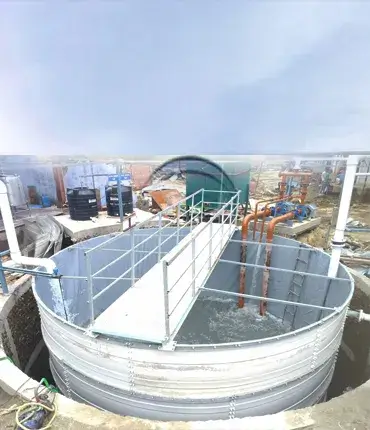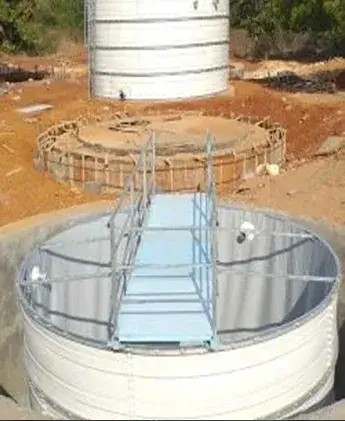Waste Water Tanks
Design And Manufactures Of Waste Water Tanks, Fabricated Storage Tanks, Prefabricated Tanks, Fire Tank, Raw Water Storage Tanks, Overhead Water Tanks, Rainwater Harvesting Tanks, Industrial Wastewater.
Industrial Wastewater and processing : Manufacturer, Supplier
The treatment of wastewater is essential prior to reinjection into the water grid or before water is re-used in processing works. With ever-increasing water costs tied with limited availability increasingly stringent legislation on contamination, globally, this as an area of key interest to clients in the following sectors:
VFAB Tanks is a specialized manufacturing and exporting company dedicated to the design, development and production of innovative water storage tanks and industrial equipment. With sufficient experience, we have earned a strong reputation as a reliable manufacturer of premium quality products such as Zinc Aluminium Steel Tanks, Industrial Fire Fighting Tanks,Industrial Wastewater and Processing Tanks,Raw Water Storage Tanks and a variety of custom products based on requirements of our customers.
- Municipal water treatment
- Mining, Food & beverage, Pharma
- Pulp and paper
- Animal Processing
- Manufacturing
- Automobile and Ancillaries
Benefits of Waste Water Tanks
- Proper Regulation - Waste water tanks securely store contaminated water, preventing leaks and protecting soil and groundwater from pollution.
- Odor Control - Equipped with vents or sealed covers, these tanks minimize unpleasant smells, improving surrounding air quality.
- Durability - Made from corrosion resistant materials like fiberglass or concrete, these waste water tanks offer long term reliability under harsh conditions.
- Supports Treatment Processes - They provide a stable holding area for waste water, enabling prompt remedy before disposal.
- Reduces Environmental Impact - By containing waste water, they prevent untreated runoff, safeguarding ecosystems and public health.
- Customizable Sizes - Available in various capacities, these waste water tanks cater to both small residential and large industrial waste water needs.
- Prevents System Overload - These waste water tanks manage excess waste water flow, reducing strain on treatment facilities during peak usage.
Application Waste Water Tanks
- Municipal Sewage Systems - Waste water tanks store sewage from households and urban areas for treatment before safe disposal.
- Industrial Manufacturing - They manage chemical laden waste water from factories, ensuring proper containment and processing.
- Agriculture and Farming - These tanks are used to store water that contains fertilizers or animal waste, so it does not harm the environment.
- Food Processing - Waste water tanks store organic waste water from production, aiding in treatment and hygiene compliance.
- Construction Sites - These tanks collect debris laden water, managing waste during building projects.
- Oil and Gas Sector - Waste water tanks store contaminated water from drilling or refining, supporting safe waste handling.
- Pharmaceutical Industry - Waste water tanks store contaminated water from drug production, ensuring safe disposal.
Why Choose Us Waste Water Tanks?
- Premium Quality Construction - We use top grade materials like stainless steel and fiberglass, ensuring durable, long lasting waste water tanks.
- Industry Expertise - With ample experience, we deliver reliable waste water storage solutions backed by proven knowledge.
- Rapid Installation Process - We ensure quick and efficient setup of waste water tanks, reducing downtime and keeping your operations on track.
- Compliance Assurance - Our tanks meet stringent standards like EPA regulations, guaranteeing safety and environmental protection.
- Low Maintenance Systems - Designed for easy cleaning and durability, our waste water tanks reduce upkeep costs and efforts.
- Proven Reliability - Trusted by diverse industries, our waste water tanks consistently deliver secure and efficient storage.





Product Details of Waste water Tanks
Waste water tanks are specialized storage units designed to hold and manage water that has been used in domestic, industrial and agricultural processes, containing contaminants such as organic matter,chemicals and solids. These tanks are typically constructed from durable materials like reinforced concrete, fiberglass or polyethylene, selected for their resistance to corrosion and ability to withstand the harsh composition of waste water.
The design of waste water tanks focuses on containment and structural integrity, often featuring thick walls, leak proof seals and protective coatings to prevent environmental leakage. Capacities vary widely, from small residential septic tanks to large industrial units, depending on the volume of waste water generated. To manage odors and gases produced by decomposition, many tanks include ventilation systems or gas tight covers, while inlet and outlet pipes facilitate the flow of waste water into and out of the tank for treatment. Regular maintenance is critical as it involves inspection for cracks, sediment buildup or corrosion, as well as periodic cleaning to remove sludge and ensure functionality.
Environmental factors such as temperature and rainfall, can affect tank performance, sometimes requiring insulation or overflow mechanisms.